 |
Burke, Edmund R. (1999). Optimal Muscle Recovery: Your Guide to Achieving Peak Physical Performance. Pub. Avery, New York, Ed. Peggy Hahn, pp. 214. Available
online. Avery is a member of Penguin Putnam Inc. Food - Important for all athletes, but critical for the endurance athlete. The book promotes the R4 System of Restore (Fluids and minerals), Replenish (Glycogen), Reduce
(Damage to muscle and the immune system), and Rebuild (Muscle protein). A useful reference book for all nutrients and many current ergogenic (performance enhancing)
nutritional aids. Replenishment of electrolytes and liquids, as well as the optimal levels of sugar solutions for rapid assimilation, are important features that have evolved
during the 1990s. More recent research on carbohydrate solutions incorporating 25% protein have furthered this previous work in enhancing endurance performance. The
book acknowledges that food alone is not the sole route to speed and endurance - training is essential and recovery may involve massage, stretching, saunas, etc. - as well as
ensuring proper dietary intake. Dr Burke discusses the optimal nutritional needs of athletes in terms of Performance Daily Intakes (PDIs) that are far higher than traditional
Recommended daily Intakes (RDIs) which he describes as basic minimum levels. Discussions (pros and cons) and recommended dosages are provide for many sports
supplements including caffeine, creatine, beta-hydroxy beta-methylbutyrate (HMB), phosphatidylserine (PS), and ribose.
A MUST READ if you are interested in understanding how food affects your athletic performance and recovery. |
 |
Cleveland, Marcia (1999). Dover Solo: Swimming the English Channel. Pub. MMJ Press, Canada, pp. 176. Available from Marcia Cleveland - check Marcia's web site.
Marcia swam the Channel from England to France in 9 hours 44 minutes on 29th July 1994 - a top-class time. This book details her preparation for the swim from the first
thoughts, through all of the training and planning, to the successful swim. She provides an excellent description of the challenges of cold-water training, feeding tips, mental
preparation, and the importance of the support of her husband, Mark. While she concludes "A Channel swim is best experienced by living it", her book provides the virtual
experience for those who, otherwise, will never get there. Through the book, I re-lived many cold-water training experiences.
A MUST READ for all cold-water, marathon swimmers - especially if you have aspirations on The Channel. |
|

|
Cox, Lynne. (2004). Swimming to Antarctica: Tales of a Long-Distance Swimmer. Pub. Knopf, Random House, New York, Ed. Vicky Wilson, pp. 323, $24.95 USA, $35.95
Canada. Available discount, online at Amazon-USA, Amazon-Canada, and Chapters-Indigo Canada. Contrary to traditional teachings of survival in open-water, maximizing survival-time when un-clothed in cold water below 10°C, and particularly below 5°C, requires a high
output of energy. Consequently, it is not surprising that one of the greatest, and definitely most famous, cold-water endurance swimmers, Lynne Cox, also held the record for
the fastest crossing of the English Channel.
This is a riveting story from her entry into open-water swimming in 1970 at age 13, setting records for the Catalina Channel and English Channel in each of the three
following years, through to her nerve-numbing, 1.06-mile swim, 32 years later in the 32°F waters of Antarctica. Included within this period are a whole series of amazing
stories of swims blended in a dream of contributing to World Peace. Sewage and pollution encounters in a professional swim in Egypt that caused life-threatening dysentery.
The frightening experience of being lost in the fog from the main boats and having to abandon a swim with just a surf-board support in the Catalina Channel. The tensions of
a 28-minute swim through broken ice in the 38°F waters of Glacier Bay. The frustrations with the time-consuming vagaries of telemetry pills to measure core
body-temperature. Details of the role of the crew in overcoming the apparent hopelessness in the middle of a swim, and the subsequent thrill of being accompanied by
dolphins in the final stages of her swim across Cook Strait. The story of gigantic, crashing waves, sea snakes, and a shark attack on a swim around the Cape of Good Hope.
Snow, freezing temperatures, and whirl pools while crossing the Straits of Magellan. Throughout these stories, Lynne writes of her emotions and the thoughts that passed
through her mind to keep her alert and to maintain her determination to finish in such adverse conditions while, all the time, relating to her dream to contribute to World
Peace.
A MUST READ for all cold-water, endurance swimmers, or anyone wanting an insight into the forces that drive such swimmers to achieve their goals. |
 |
Dean, Penny Lee (1998). Open Water Swimming: A Complete Guide for Distance Swimmers and Triathletes. Pub. Human Kinetics, Champaign, Ill, pp. 224. I obtained my
copy through Chapters book store.
In 1978, Penny Lee Dean became the fastest person to cross the English Channel in 7 hours 40 minutes. A women's record that still stands in 2002 and has only been
improved upon by one man - Chad Hundeby's 7:17 in 1994. It is with this background of competition, 13 open-water records, and a background of coaching that Penny Lee
Dean lays out what is effectively the definitive book on open-water swimming. It covers swimming gear (also wet suits), water safety (hypothermia to support boats), tips on
swimming straight, stroke drills and training (for the freestyle swimmer), advice on navigation (in the water and from the boat), stretching, mental training, relaxation
techniques, equipment lists, planning the swim, nutrition (before, during, and after the swim), competitions and contacts, racing strategies, and much more. Beware - the
training programmes reflect the workload of a top-class marathon swimmer!
An ESSENTIAL REFERENCE MANUAL, this book does not require reading from start to finish in one go - you'll keep coming back to it. |
 |
Forsberg, Gerald (1963). Modern Long Distance Swimming. Pub. Routledge & Kegan Paul, London, pp. 230.
Comprehensive coverage of long-distance (5-10 miles) and marathon open-water swimming during the early years (up to 1962) around the British Isles. Plenty of
photographs of swimmers, and illustrations of courses. It includes material on the Morecambe Bay Swimming Association, the British Long Distance Swimming
Association, and the Channel Swimming Association. Details are given for Torbay, the Solent, Bala Lake, Coniston, Ullswater, Windermere, Loch Lomond, Loch Ness,
Lough Neagh, and the Irish Channel.
A USEFUL out-of-print, reference book covering the development of long-distance swimming in Great Britain (including the Channel) with details of swims up to the
1960s. Available in many libraries. |
|
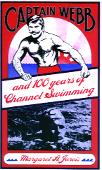
|
Jarvis, Margaret A. (1975). Captain Webb and 100 years of Channel Swimming. Pub. David & Charles, Newton Abbot, Devon, England, pp. 64. Originally priced £2.95, now
out of print. My copy came via the Internet from G & D Marrin & Sons, England for £20 plus shipping in 2003. Apart from detailed accounts of Channel swims by Captain Webb and many others during the first 100 years, this book has numerous photographs of the swimmers,
including all but 4 of the 22 record holders from that 100-year period. With so many photographs and swimmers, the weakness of this book is an index. Statistics have
obviously changed since 1975 (237 crossings at that time vs 887 by the end of 2003), but that does not detract from the allure of this book. False claims of swims led to the
formation of the CSA in 1927; these false claims and the resultant rules of the CSA are described.
An important documentation of swims and swimmers from the first 100 years. The photographs and swimmer records are a COLLECTOR'S TREASURE. Here is the
reviewer's index of the swimmers . |
|

|
Leveridge, A.W. "Bill" (1978). Fair Sport: The History of Sport at the Canadian National Exhibition, 1879-1977 Inclusive. Pub. The Canadian National Exhibition,
Exhibition Place, Toronto, Canada, M6K 3C3, pp. 363 plus 32 full pages of photos. No price indicated on my copy. The first 72 pages are devoted to the swimming competitions
and photos include George Young, the Wrigley Trophy, and Ben Gazel. Among the 80 sports featured at the Canadian National Exhibition (CNE) during its first century of operation, marathon swimming, which was first featured in 1927, was
one of the most popular. The book includes comprehensive descriptions of the achievements of George Young (First person to cross the Catalina Channel in becoming the
winner of the first Wrigley race on 15th January 1927) and Ernst Vierkoetter (Winner of the second Wrigley race which was held at the CNE on 31st August 1927). Of
particular interest are the descriptions of the body-numbing temperatures (below 10°C) that characterized the conditions in so many of these CNE races (Ranging from 10 to
32 miles) that were held during the reported century of operation of the CNE. Rules and regulations are detailed for the swims along with the complete list of international
champions (Including (Herman Willemse, Abou Heif, Cliff Lumsdon, Greta Andersen, and Judith de Nys) who were all beaten by the cold conditions of the 1964 CNE,
32-mile, cross-lake race. Details are also included of the early solo attempts to cross the lake, two deaths, and Marilyn Bell's 1954 success with the first crossing. While the
book lists all of the winners of the CNE races from 1927 to 1964, Wennerberg's book lists the finishers in each of the swims.
A COLLECTOR'S BOOK with important documentation of the early CNE swims, and especially important data on George Young, Ernst Vierkoetter, Cliff Lumsdon and
others. |
|
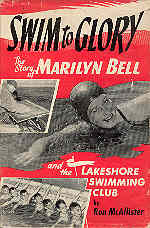
|
McAllister, Ron (1954). Swim to Glory: The Story of Marilyn Bell and the Lakeshore Swimming Club. Pub. McClelland & Stewart Limited, Toronto, Canada, pp. 128, 42
photos including the cover sheet. No index. Out of print. My copy was ordered on the Internet from Chapters.Indigo.ca, Canada and, in 2004, cost $50.70 Canadian, plus taxes and
shipping costs; however, it arrived from a source in the U.S.A. and so encountered additional import taxes. Printed within two months of Marilyn's historic 1954 crossing of Lake Ontario, this book provides a history of Marilyn's swimming and association with Gus Ryder and his
famous Lakeshore Swimming Club. The story is recounted of the Canadian domination of the 1954 Atlantic City professional swim, with Marilyn winning the ladies' event,
while Tom Park and Cliff Lumsdon took the first two places in the mens' event. Gus Ryder was coach of all three swimmers, and details are given of his life and his
formation of the Lakeshore Swimming Club, along with stories of four-times World Champion Cliff Lumsdon, and George Park who was the winner and only finisher in the
1927 Wrigley race to cross the Catalina Channel. Cliff's surname, however, is consistently spelled incorrectly in the book. A review is also included of previous marathon
swims in Toronto.
The theme throughout the book is Marilyn's conquest of Lake Ontario, the associated competition with English Channel conquerors Florence Chadwick (American) and
Winnie Roach-Leuszler (Canadian), the camaraderie of the Lakeshore Swimming Club, and Marilyn's friendship with Joan Cooke - a friendship that was to last a lifetime.
Apart from the factual details of Gus Ryder, the swimmers, and their swims up to 1955, the numerous photographs are a treasure.
An ESSENTIAL REFERENCE book on Marilyn Bell, Cliff Lumsdon, George Young, and Gus Ryder. |
|
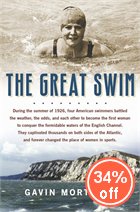
|
Mortimer, Gavin (2008). The Great Swim. Pub. Walker& Company, New York, Ed. Liz Peters, pp. 326. More than six years in preparation, this book reflects the painstaking detail involved in its compilation. Reference Notes are provided for each of the chapters, along with a
comprehensive index to locate the numerous swimmers and associated individuals.
1926 witnessed an intense swimming battle between a number of ladies to become the first woman to cross the English Channel. In this book, the various swims are
described of Gertrude (Trudie / Trudy) Ederle, Mille Gade (Corson), Lillian Cannon, Clarabelle Barrett, and Mercedes Gleitz. While Gertrude Ederle's 14:39 broke
Tiraboshi's 1923 men's record of 16:33 to become the first woman with a successful crossing, she was only 23 days ahead of Mille Gade who crossed in 15:29. The
significance of these 23 days on the subsequent financial rewards, acclamations, and response of the news media are an intriguing part of the story that would impact the rest
of Trudy Ederle's life.
Mortimer credits many people for providing data for the book, including Dover Museum an administrative staff of the CSA; however, there is no reference to information
from current pilots or the CS&PF. The issue on pilots is relevant, since Mortimer clearly criticizes a 1925 New York Times report that noted the tides change every 5.75
hours and he maintains in 2008 that they shift direction every 6 hours. If such were the case, high tide would occur at the same time every day !
The early development of the swim suit from wool or rubber (described for the start of Tiraboshi's swim) to silk is described, along with Trudy's sister Margaret's
development of a two-piece silk suit for her successful 1926 swim - i.e. 20 years before Louis Reard patented the word "bikini".
The movement of the tides and their strength (Spring vs Neap) within the Channel are a primary governing factor in a successful crossing. These features are discussed
throughout the book, along with the need to avoid major sandbanks (Goodwins, Varne . . .) and the entrances to the harbours of Dover and Calais.
An INSPIRATION to any modern-day aspirants to marathon swimming, this book contains a wealth of historical information on these swims and the impact on the lives of
these pioneering women swimmers and their families. |
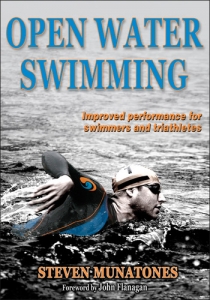 |
Munatones, Steven (2011). Open Water Swimming: Improved performance for swimmers and triathletes. Pub. Human Kinetics, Champaign, Ill, pp. 254.
This book is the most up-to-date knowledge-base on open-water swimming for competitive swimmers, triathletes, and solo swimmers.
Steven Munatones is currently the world authority on open-water swimming and this book has something for everyone as it covers: preparation for a variety of distances and
events; the associated training; racing tactics; navigation; feeding; and much more. References and links are provided for all of the major international open-water events.
An ESSENTIAL REFERENCE MANUAL for all swimmers - FINA competitor, triathlete, or solo swimmer. |
 |
Nyad, Diana (1978). Other Shores. Pub. Random House, New York, pp. 174. No longer in press, but excellent copies are available second-hand online at Amazon.
Here's one of the rare chances to get into the mind of a top-class marathon swimmer who is a skilled writer/reporter. Record breaking swims across Lake Ontario and around
Manhatten Island, a challenging climb on Kilimanjaro, two major attempts on the English Channel and plans for a Cuba-to-Florida swim are all covered in this book. Details
of feeding and energy uptake are described along with the challenges (disasters) in feeding that may be expected as you move from fresh water to ocean.
This book provides a lesson in waiting for the correct weather. Challenging the weather on marathon swims rarely leads to record fast times, and Diana's experiences on The
Channel reflect this fact. A number of swimmers have crossed Lake Ontario and never learnt of its fickle nature; after a series of days with a northerly wind, the water
temperature around Toronto can readily drop 20°F overnight. I've experienced this effect during training swims, and Diana's report effectively describes the unwitting
swimmer's response to this phenomenon.
The typical reporter's question of "What do you think about?" is answered in many ways in this book, in terms of what worked for Diana. The challenges of being a woman
swimmer on the Professional circuit in the 1970s are also well described and reflect her strong beliefs as a feminist.
Still VERY RELEVANT and STIMULATING. It is worth the trouble of seeking a second-hand copy (generally obtained from old library stocks and they can be in
surprising good condition). |
|
 |
Renford, Des with Ian Heads (2000). Nothing Great is Easy. Pub. Pan Macmillan Australia, Sydney, pp 311. Available online from sources in Australia. I failed to find a North
American source, but obtained speedy delivery from Andrew's Bookshop in Australia.. Des Renford, 1927-1999. This book is more than swimming - it is about a love of life that involved time in the Australian navy in WWII, a life-long marriage to Patty from
1946, work as a prize fighter, illicit bookmaker activities, horse racing and dog racing, life as a rock-star manager, work as a politician, an amazing career in marathon
swimming - retiring as King of the Channel with 19 crossings - and a dedication to helping others, not just in the Channel but through the Special Olympics, and more . . .
The incredible willpower of Des (19 attempts on the Channel and 19 successes) is described through his mental and pain barriers, the euphoria beyond those barriers, and the
closeness to death in that painless zone. Encompassed in this book is one man's inspiring response to three major heart attacks, open-heart surgery, and a cerebral stroke.
Read Des's view of the battles for King of the Channel that he had with Kevin Murphy and Mike Read. His details of the "triple challenge" with Kevin Murphy, which
involved swims in Sydney Harbour, the Channel, and the Loch Ness finale that had them both on the verge of death. Des gives a great insight into the challenges and abuse
of caged swims in shark-infested waters, as well as his views on wet-suited swims. This is an amazing story of Australian camaraderie and Des's mates, particularly the
support of John Devitt. It describes the numerous events leading to Des's receipt of the MBE and a papal Knighthood.
Make sure to get the updated "revised" edition, released in 2000 after Des's death. Read it from start to finish, and you will emerge as a wiser marathon swimmer and, if Des
weaves his magic on you, emerge as a better person.
A MUST READ for anyone who wishes to understand the mind of a top-class marathon swimmer who started as he approached 40. |
 |
Rockett, Sam (1956). It's Cold in the Channel. Pub. Hutchinson, London, pp. 191. Out of print, but available from libraries or second-hand.
Excellent coverage of Channel swimming up to the mid-1950s, this book is the Channel equivalent of Wennerberg's book on swimming in North America. Details are
provided of the professional races organized by Billy Butlin and the Daily Mail. Many of the early record holders (Egyptians, North Americans and British) in the Channel
are described, plus an excellent chapter by Dr Pugh on Physiological Aspects of Channel Swimming.
ESSENTIAL background reading and early reference material for the serious Channel swimmer. |
|
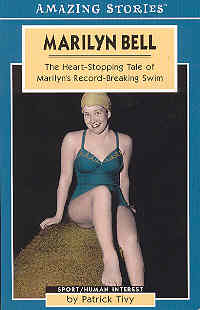
|
Tivy, Patrick (2003). Marilyn Bell: The Heart-Stopping Tale of Marilyn's Record-Breaking Swim. Pub. Altitude Publishing Canada Ltd., Canmore, Alberta, Canada, pp. 133, 3
photos including the cover. No index. $9.95 Canadian, $7.95 USA. Also available online from Chapters-Indigo.ca . Apart from the 19-page last chapter and the 23-line Epilogue, this book is a virtual re-write of Ron McAllister's 1954 book - to the extent of consistently spelling Cliff
Lumsdon's name incorrectly ! It does contain 3 photographs, two of which do not duplicate the numerous excellent images in McAllister's book. The final chapter takes other
published material to describe the intensive battle between The Telegram and Toronto Daily Star newspapers to capture and publish the stories surrounding Marilyn's swim.
The most important contribution of the book is again in its last chapter with its detailed description of the finish of the swim. The Epilogue briefly mentions Marilyn's swims
on the Channel and the Strait of Juan da Fuca, her subsequent family life, and her election to the Order of Ontario in 2002.
A LOW-COST, CONVENIENT, compact, paper-back report of Marilyn Bell's conquest of Lake Ontario that should have given greater credit to its virtual reproduction of
Ron McAllister's 1954 book. |
 |
Watson, Kathy (2000). The Crossing: The curious story of the first man to swim the English Channel. Pub. Headline, London, pp. 245. Available from booksellers and also
online from Amazon.
A wonderful, riveting, biography of Matthew Webb from his birth on 19th January 1848 in Dawley, Shropshire to his untimely (some say foolhardy) death at Niagara Falls at
age 35 on 24th July 1883. He will be forever remembered for his pioneering, successful, unaided crossing of The Channel on 24-25th August 1875 - after a previously
unsuccessful attempt that was thwarted by terrible conditions after almost seven hours on August 12th.
Webb's life was not easy, starting as a trainee in the Merchant Navy at age 12 and rising to sea Captain. His Channel crossing was also overshadowed by the greater publicity
Paul Boyton had received for his crossing the year previous to Webb - Boyton floated, sailed and paddled in Merriman's 1872 invention of a life-preserving suit - a sad result
for the greatest swimming achievement of that age! Webb used breaststroke while faster sidestroke swimmers consistently failed to match his endurance. Kathy Watson's
book covers details of planning and feeding as well as Webb's frustrations with many of his ventures and his subsequent struggle to earn a living as a swimmer - with
exhibitions and races in both England and the USA.
A MUST READ for anyone interested in the start of Channel Swimming and the hardships encountered by Webb. |
 |
Webb, Captain: The Channel Swimmer (1999). The Art of Swimming. Pub. Prior Publications, Whitstable and Walsall, England, Ed. A.G. Payne, pp. 117. Available from the
Channel Swimming Association.
This is a reproduction of the original book that was first published around 1876 by Ward, Lock and Tyler of Warwick House, Paternoster Row, London. Described as an
account of Captain Webb's epic swim, his instructions on swimming, and details of other feats of the period. As Kathy Watson indicates in her book The Crossing, this is a
curious book in terms of its authorship. The last chapter of 43 pages on Recent Remarkable swimming Feats are actually signed by the editor, A.G.P. The book is an
interesting description of Webb's childhood and swimming strokes of the time and is an important historical document. Watson's book, however, is a more comprehensive
story of Webb's life and swimming career.
An important book for the historian and collector that should be read in association with Kathy Watson's book. |
 |
Wennerberg, Conrad (1997). First published 1974. Wind, Waves, and Sunburn: A Brief History of Marathon Swimming. Pub. Breakaway Books, New York, pp. 348. I
obtained my copy through Chapters book store.
Excellent coverage of marathon swimming in North America up to the mid-1970s, with lots of interesting, factual data. Plenty of photographs of swimmers, and illustrations
of courses. The inductees of the Marathon Swimming Hall of Fame are listed up to 1996, and a one-and-bit page Afterword provides a cryptic precis of The Last Twenty
Years, with a focus on the Channel and Alison Streeter. Read of the 1964 Lake Ontario cross-lake swim whose torturous falling temperature beat the whole field of 23
entrants of the World's best marathon swimmers, including Abouf Heif, Judith De Nys, George Park, Charles Grover, Greta Anderson, Ken Jensen, Mohomed Zaitoon, Cliff
Lumsdon, and Kurt Pluntke. This potential for thermal inversion has featured in many of the professional races on Lake Ontario where summer water-temperatures below
10°C (50°F) are still not uncommon off the shore of Toronto during the summer months - after several days of a northerly wind. One notable error on page 112 in reporting
Brenda Fisher as the second person to cross Lake Ontario, when she was the third person after Marilyn Bell and John Jaremey.
An ESSENTIAL source of historical data for North American swims, especially on Lake Ontario and Lake Michigan. |
|
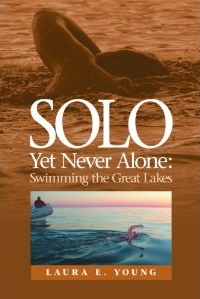
|
Young, Laura E. (2014). Solo, Yet Never Alone: Swimming the Great Lakes. Pub. Scrivener Press, Sudbury, Ontario, pp. 310, $22.95 CDN. Available from Amazon (Canada,
USA, UK), Chapters-Indigo, Canada, and others listed on the publisher's web site.
Swimmer and writer, Laura Young, has put together a wonderful collection of the stories of over 40 Canadian swimmers, and their challenges with trying to swim across one
or more of North America's five Great Lakes. Success and defeat among swimmers from 14 to 62 years old, with the women out-numbering the men. A whole range of
body-sizes, including one lady who was a previously ripped body-builder, and all with a dream of emulating 16-year-old-Marilyn-Bell's 1954 crossing of Lake Ontario.
Many of those dreams also including visions of setting speed records, new course records, and/or age records.
Able-bodied swimmers in general, with an amazing array of swimmers overcoming challenges from diabetes, cerebral palsy, Asperger's syndrome, with one swimmer with
bilateral above-knee amputations and another amazing swimmer with amputations on all four limbs. How did they handle the challenge of overcoming, or submitting to,
injuries acquired during the lead-up training and during the swim? Decisions on whether to progress and possibly suffer long-term damage are common . . . hallucinations
from sleep deprivation . . . and how do you warm your hands in the middle of the night?
From Marilyn Bell onwards, it is surprising to read how many of these individuals had competed in professional races for a variety of monetary awards; however, there are
others who had never swum competitively, or with a club, and many who compressed preparation into 12-month windows. For many it was a short-term commitment before
they moved onto other challenges, and only a few of the swimmers appear to have carried serious swimming into later life. Laura's interviews were conducted within
one-to-sixty years after the swimmer's venture on the Great Lakes and give the impression of a timeless nature about the comments.
Swimmers fuelled by carefully controlled diets for diabetics and vegetarians, along with corn syrup, electrolyte drinks and protein mixtures, through to Big Macs, potato
chips, Smarties, and more.
Each section is easily read and the book has excellent illustrations of the various courses. The power and beauty of the lakes is emphasized by the use of segments of songs
by Canadian artists Stan Rogers, and Tony Dekker of the appropriately-named group Great Lakes Swimmers. While reading the reports on Lake Superior, many will
remember its potential power for destruction that was reflected in Canadian Gordon Lightfoot's song of the demise of the Edmund Fitzgerald.
The motivation and planning for the individual swimmers is varied. Many swam for charities, with some being sponsored by the associated fund-raising, and raising totals
for their selected charities ranging from a few thousand dollars to one that, with matching funds, garnered a massive $650k.
Readers may be seeking to understand what's required to swim across a Great Lake without a wet suit or other aid-to-swimming, while others may have an interest in finding
out "Have I got what they've got?" There are no simple answers, but the variety of responses provides a greater appreciation of what is involved. With the speed at which
storms can change the lakes in their patterns of wind and waves, or their overnight ability to plummet in temperature, swimmers note that they have no control over the lake,
or that they greatly under-estimated the difficulty . . . while an enviable few found that elusive "window" of calm and warmth for the duration of their swim.
Through her probing and personal interviews with these swimmers, Laura has extracted a variety of fascinating details about the swimmers and their swims.
A riveting series of personal stories and views of the challenges to swim across a Great Lake, with insights into the minds of those who might seek to take-on such a
challenge.
An MUST READ for those wanting to understand the challenges of swimming across any one of North America's 5 Great Lakes, or obtaining some small view into the
minds of the amazing range of swimmers - both able-bodied and with physical challenges. |

















